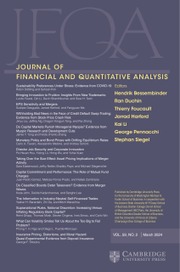No CrossRef data available.
Article contents
The Lender’s Lender: Trade Credit and the Monitoring Role of Banks
Published online by Cambridge University Press: 07 April 2025
Abstract
A firm’s role as lender to its customers (via trade credit) is influenced by the firm’s own lenders. With a novel data set of trade credit between U.S. public companies, I find that firms limit customer credit concentrations, extending less generous trade credit to customers as the firms’ sales dependence on them increases. Evidence points to lenders influencing firms to limit credit concentrations: First, cross-sectional variation shows stronger results with greater lender monitoring intensity. Second, analysis of granular loan contract details reveals that concentration limits in borrowing base formulas are a clear, previously unexplored way banks influence trade credit policies.
- Type
- Research Article
- Information
- Creative Commons
- This is an Open Access article, distributed under the terms of the Creative Commons Attribution licence (http://creativecommons.org/licenses/by/4.0), which permits unrestricted re-use, distribution and reproduction, provided the original article is properly cited.
- Copyright
- © The Author(s), 2025. Published by Cambridge University Press on behalf of the Michael G. Foster School of Business, University of Washington
Footnotes
I thank George Pennacchi (the editor) and an anonymous referee for their valuable feedback. I also thank Matthew Billett, Daniel Carvalho, Filipe Correia, Janet Gao, Jie (Jack) He, Kristoph Kleiner, Haizhen Lin, Vojislav (Max) Maksimovic, Justin Murfin, Jeffry Netter, Annette Poulsen, Merih Sevellir, Noah Stoffman, Greg Udell, Malcolm Wardlaw, Xiaoyun Yu, seminar participants at Indiana University, and conference participants at the EFA 2019, FMA 2019, and MFA 2020 conferences for their valuable input. An earlier job market iteration of this paper circulated as “The Economics of Trade Credit: Risk and Power.” Funding: Freeman gratefully acknowledges funding from the Terry College’s Terry-Sanford awards.


